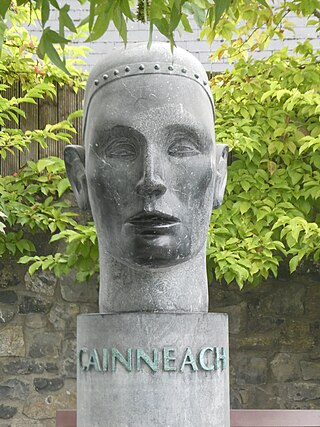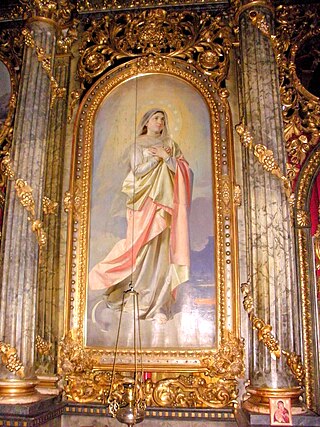
Saint Brigid of Kildare or Saint Brigid of Ireland is the patroness saint of Ireland, and one of its three national saints along with Patrick and Columba. According to medieval Irish hagiographies, she was an abbess who founded the important abbey of Kildare, as well as several other convents of nuns. There are few documented historical facts about her, and her hagiographies are mainly anecdotes and miracle tales, some of which are Christianisations of hero tales from Irish mythology. They say Brigid was the daughter of an Irish clan chief and an enslaved Christian woman, and was fostered in a druid's household before becoming a consecrated virgin. She is patroness of many things, including poetry, learning, healing, protection, blacksmithing, livestock and dairy production. In her honour, a perpetual fire was kept burning at Kildare for centuries.

Dymphna is a Christian saint honoured in Catholic and Eastern Orthodox traditions. According to tradition, she lived in the 7th century and was martyred by her father.

Christian monasticism is a religious way of life of Christians who live ascetic and typically cloistered lives that are dedicated to Christian worship. It began to develop early in the history of the Christian Church, modeled upon scriptural examples and ideals, including those in the Old Testament. It has come to be regulated by religious rules and, in modern times, the Canon law of the respective Christian denominations that have forms of monastic living. Those living the monastic life are known by the generic terms monks (men) and nuns (women). The word monk originated from the Greek μοναχός, itself from μόνος meaning 'alone'.

March 23 - Eastern Orthodox liturgical calendar - March 25

March 26 – Eastern Orthodox liturgical calendar – March 28

April 3 - Eastern Orthodox liturgical calendar - April 5

April 8 - Eastern Orthodox liturgical calendar - April 10

June 12 - Eastern Orthodox Church calendar - June 14

June 14 - Eastern Orthodox Church calendar - June 16

July 4 - Eastern Orthodox Church calendar - July 6

Cainnech of Aghaboe (515/16–600), also known as Saint Canice in Ireland, Saint Kenneth in Scotland, Saint Kenny and in Latin Sanctus Canicus, was an Irish abbot, monastic founder, priest and missionary during the early medieval period. Cainnech is one of the Twelve Apostles of Ireland and preached Christianity across Ireland and to the Picts in Scotland. He wrote a commentary on the Gospels, which for centuries was known as the Glas-Choinnigh or Kenneth's Lock or the Chain of Cainnech.

February 9 - Eastern Orthodox liturgical calendar - February 11

·

February 16 - Eastern Orthodox liturgical calendar - February 18

February 28 - Eastern Orthodox liturgical calendar - March 2

Iarlaithe mac Loga, also known as Jarlath, was an Irish priest and scholar from Connacht, remembered as the founder of the monastic School of Tuam and of the Archdiocese of Tuam, of which he is the patron saint. No medieval biography of Jarlath is extant, but sources for his life and cult include genealogies, martyrologies, the Irish Lives of St Brendan of Clonfert, and a biography compiled by John Colgan in the 17th century.

Ciarán of Saigir, also known as Ciarán mac Luaigne or Saint Kieran, was one of the Twelve Apostles of Ireland and is considered the first saint to have been born in Ireland, although the legend that he preceded Saint Patrick is questionable. Ciarán was bishop of Saighir (Seir-Kieran) and remains the patron saint of its successor, the diocese of Ossory.
Saint Ciera of Ireland was an abbess in the 7th century who died in 679. Her history is probably commingled with another Cera who lived in the 6th century. However, some authors maintain that monastic mistakes account for references to Cera in the 6th century or that a single Cera had an exceptionally long life span.

The Feast of the Conception of the Virgin Mary is a liturgical holiday celebrated on December 9 by the Orthodox Church and a number of Eastern Catholic Churches. It is also the name given in the Catholic Tridentine calendar for 8 December. In the present General Roman Calendar, the feast is called the Solemnity of the Immaculate Conception of the Blessed Virgin Mary. In the Eastern Orthodox Church, the holy day was once called the Feast of Conception of Saint Anne.

March 15 - Eastern Orthodox liturgical calendar - March 17







